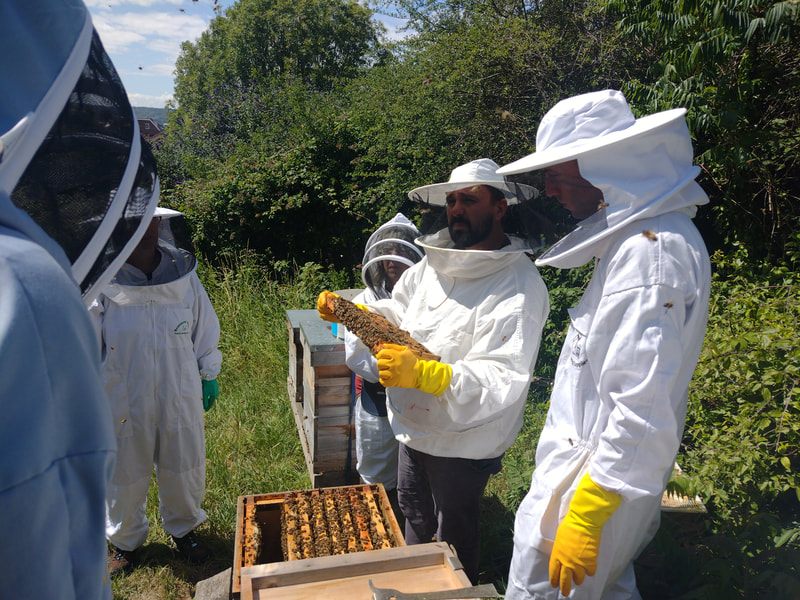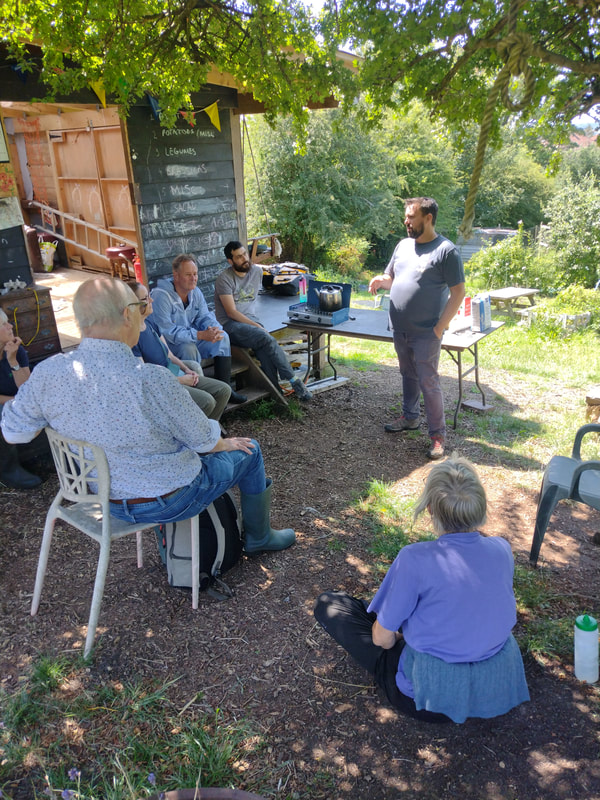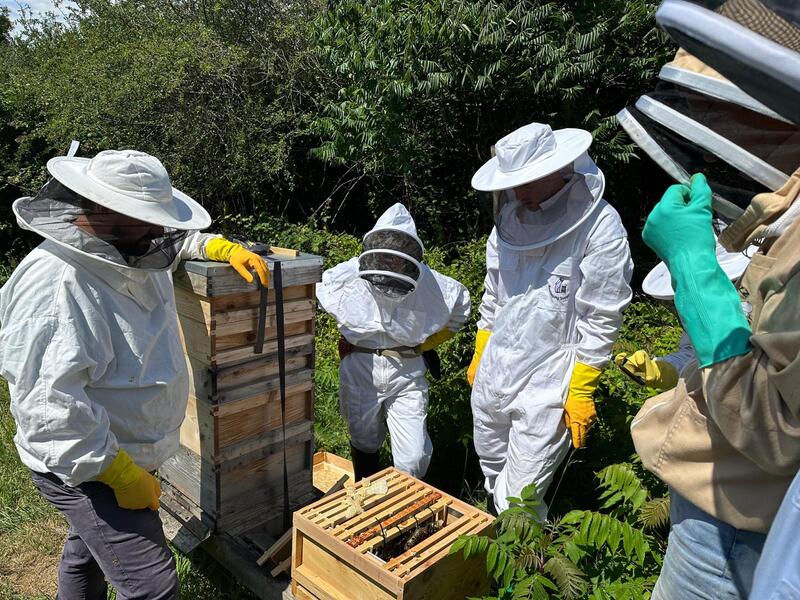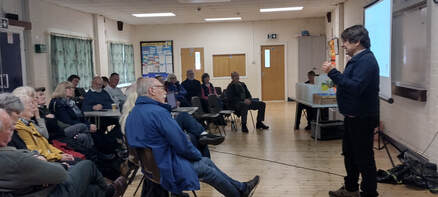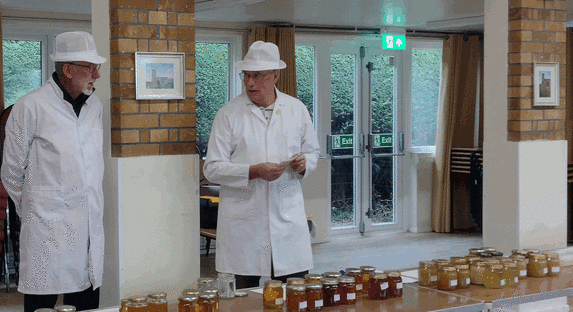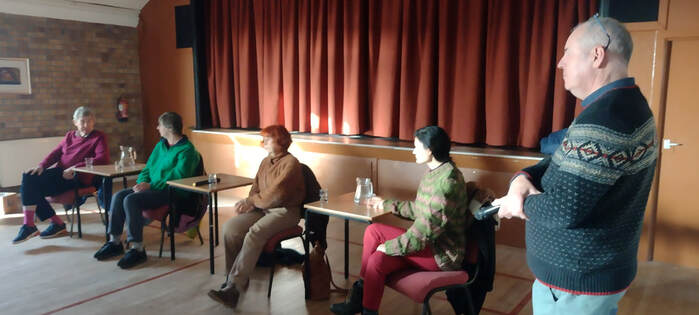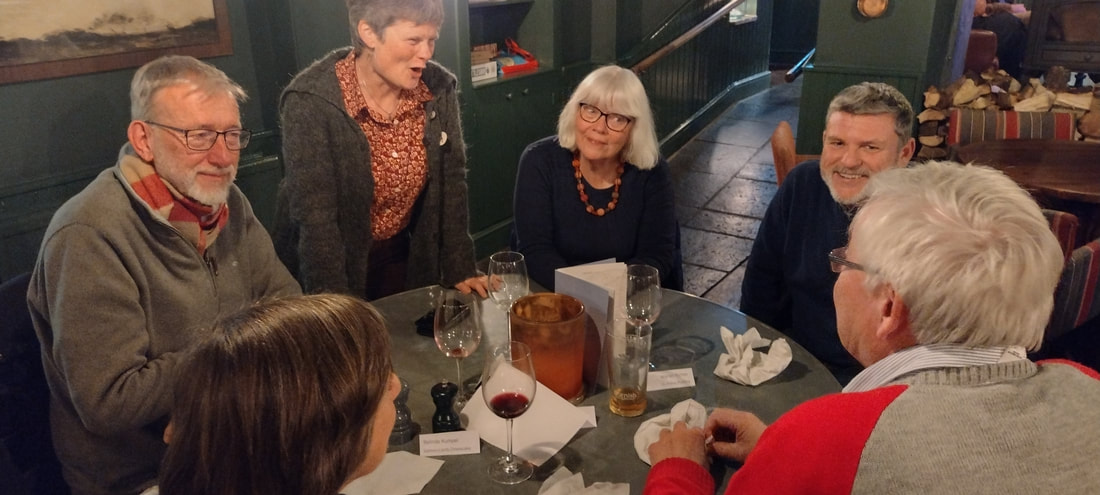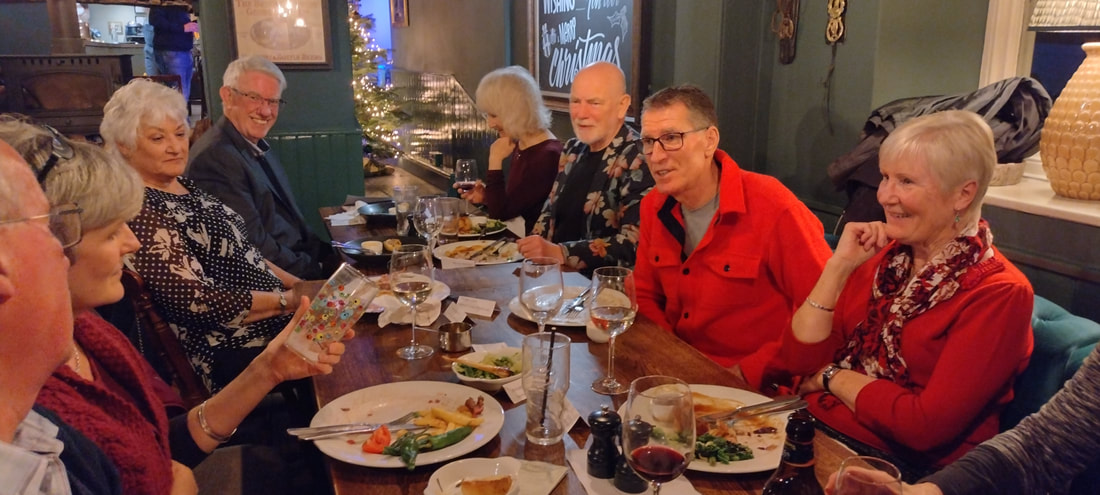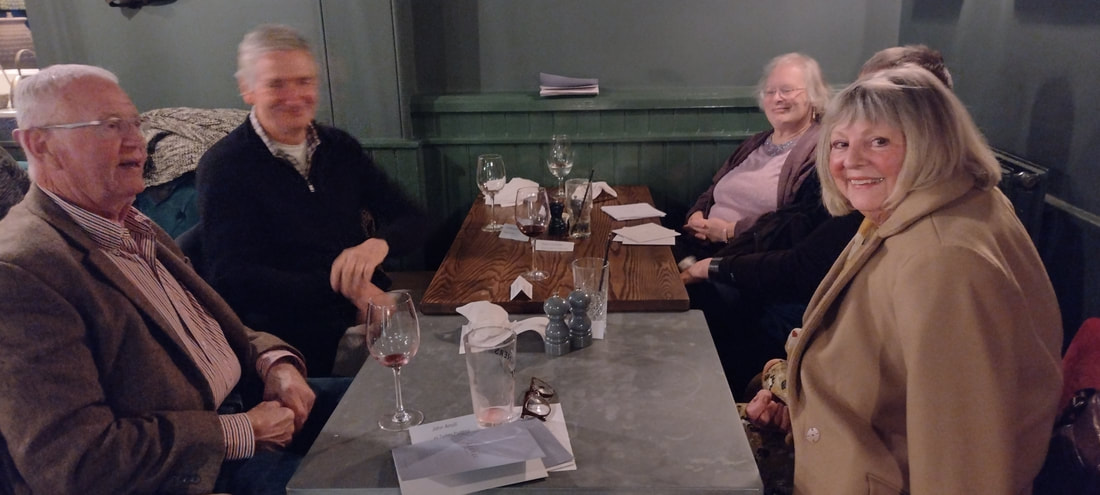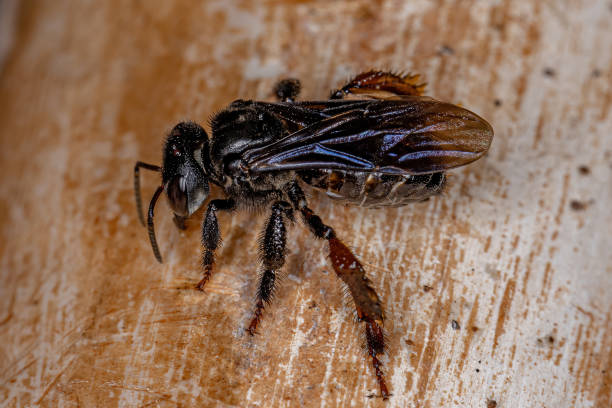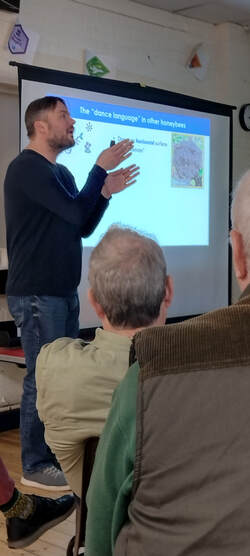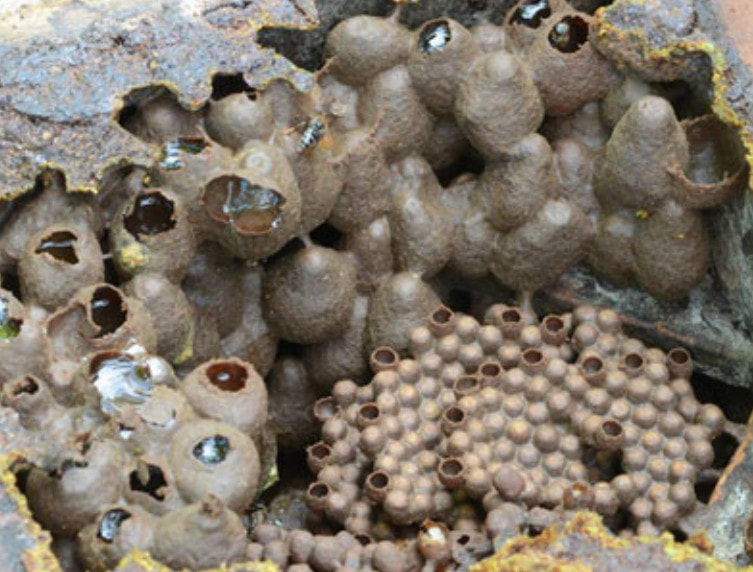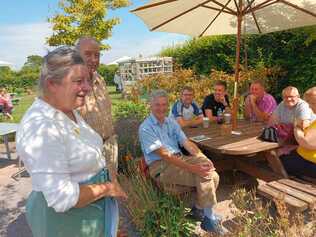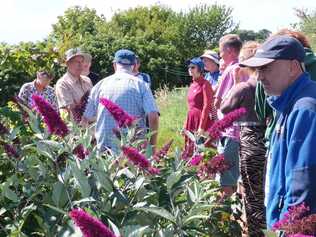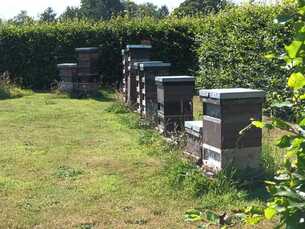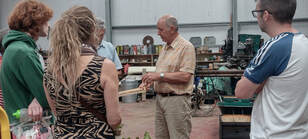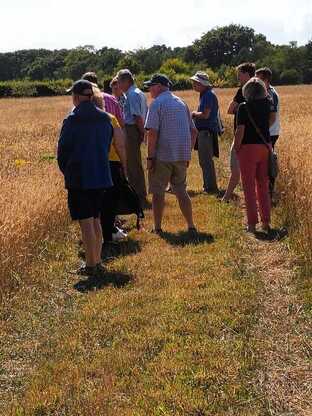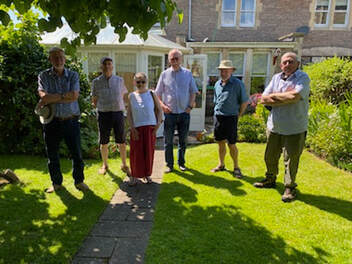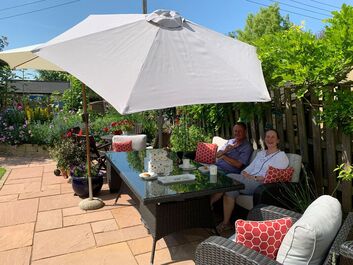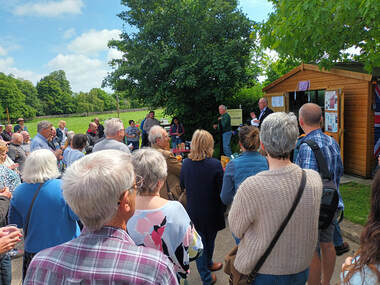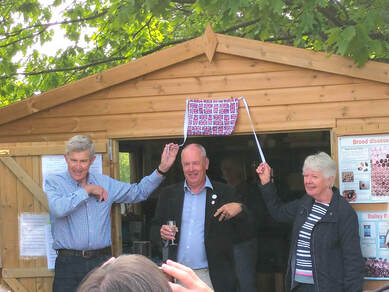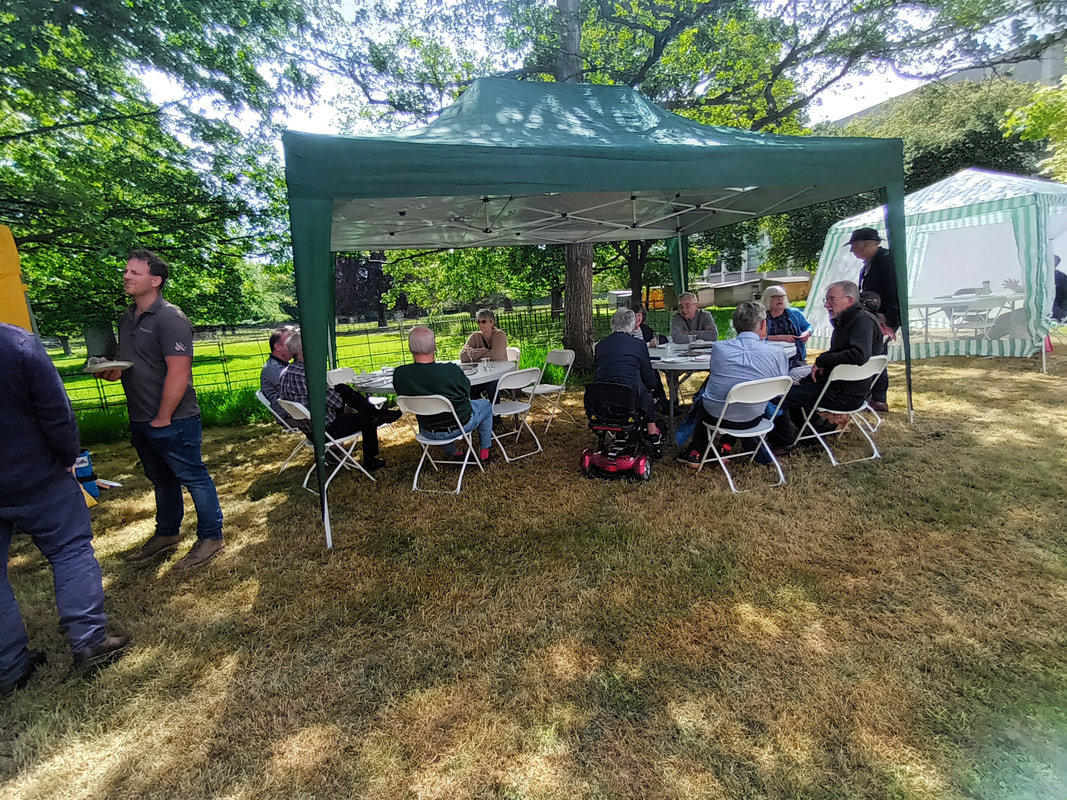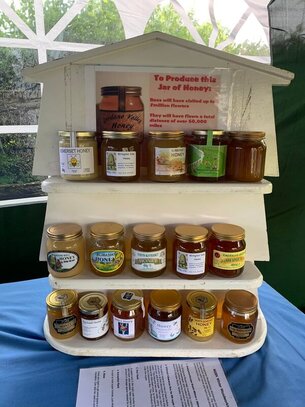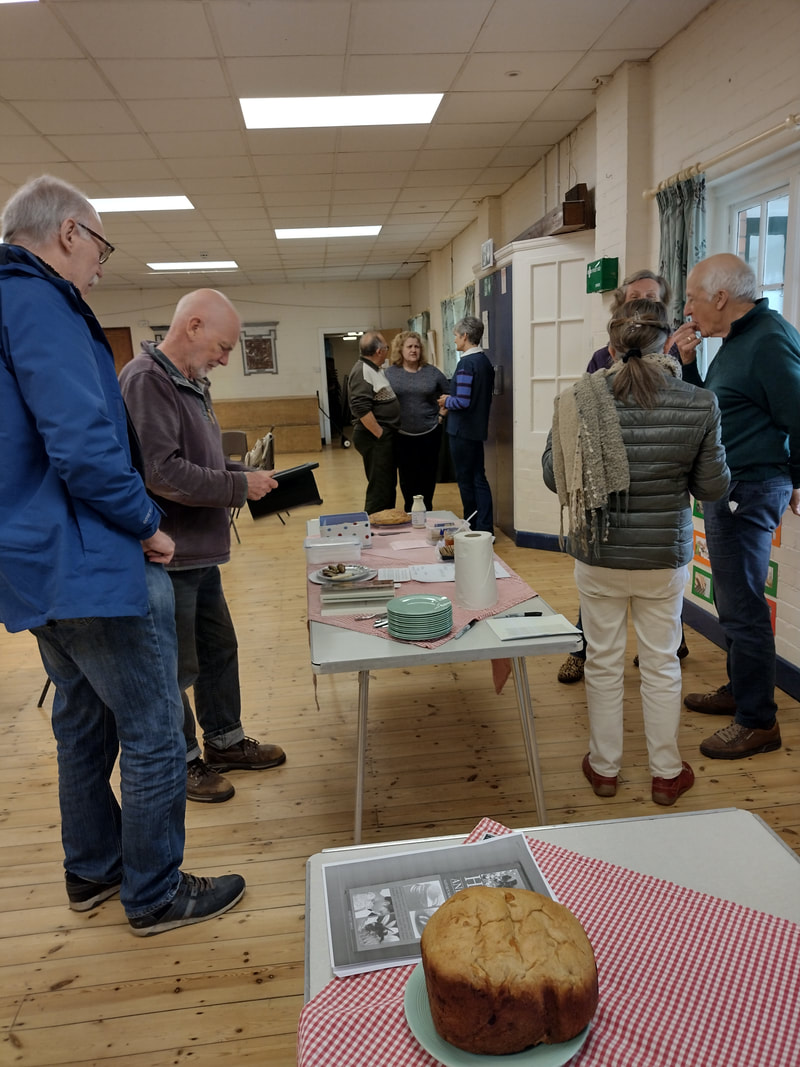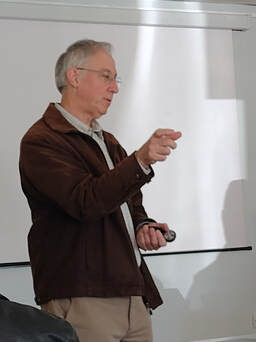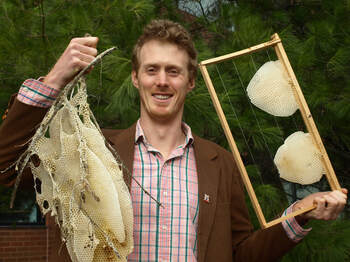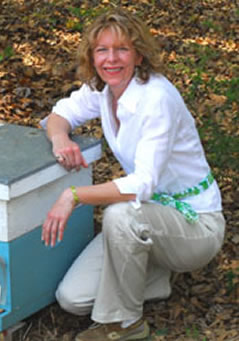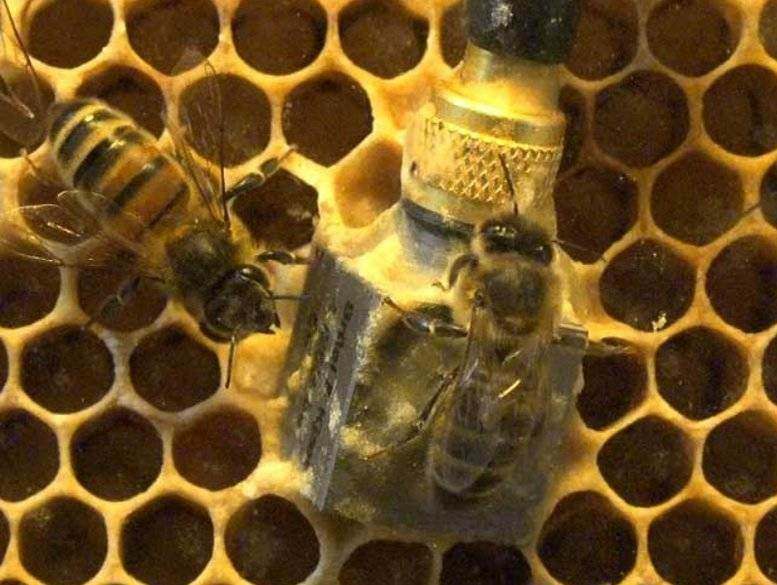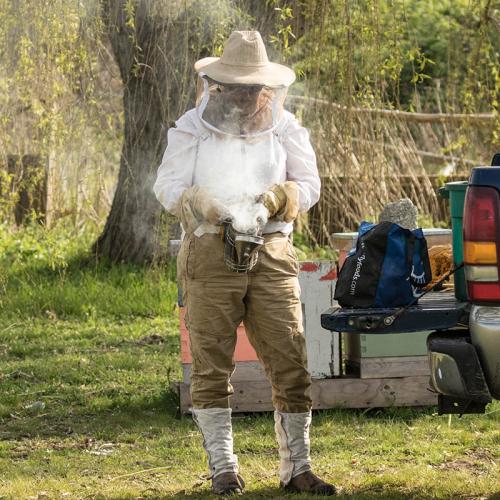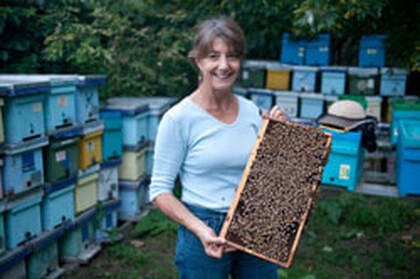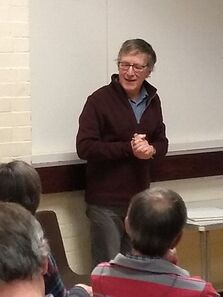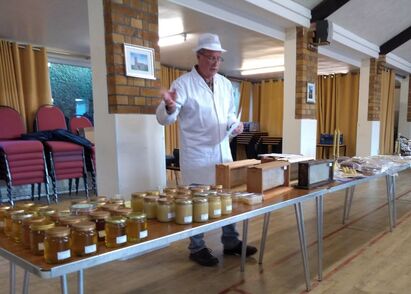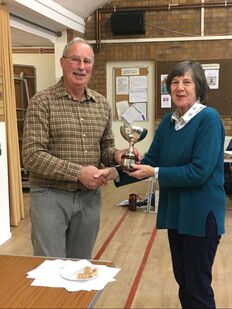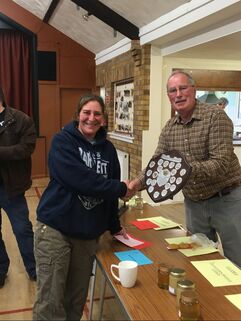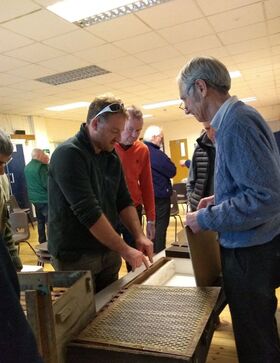NORTH SOMERSET BEEKEEPERS
|
The 2023 Bees & Teas event became reduced to a single meet-up hosted by Adam Evans at Bramble Farm in South Bristol. This is a delightful green oasis hidden in the middle of urban South Bristol. Few people know of its existence, but once seen it is never forgotten. You pass through an anonymous narrow passage between two houses and emerge onto a high grassy field with extensive views over Bristol. Down to the left are trim allotments and Bramble farm is a short walk, on the right, across the field, to the entrance gate. When the whole party had arrived Adam described the history and organisation of Bramble Farm. We then donned bee suits and assisted with the inspection of 6 colonies. Adam was aided by his two apprentices Ron and Tom, while the visitors mostly engaged with energetic discussion and Queen spotting. Afterwards Adam provided much appreciated tea and cake to conclude a very successful meeting. Rob Williams
6/7/23
0 Comments
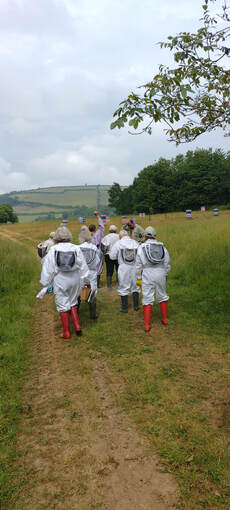 The historic apiary at Buckfast Abbey regularly welcomes parties of beekeepers as part of their new education programme. Although it is known worldwide for Brother Adam's pioneering work on the controlled breeding of honeybees during the early years of the 20th century, the facilities have now been redirected from selective Queen breeding and bulk honey production towards community support activities. Clare Densley and Martin Hann provide a great afternoon experience, starting with a relaxed seminar in the apiary shed on current topics and then leading an inspection team into their lovely Meadow Apiary. There was quite a long discussion about the poor survival of many colonies during this past winter. The generally warm weather, followed by some bitterly cold days, seem to be the cause of colonies dying or absconding. Often considerable stores were still evident in the vacated hives. Virus diseases, such as DWV (Deformed Wing Virus) and Paralysis Virus can be transmitted inter-bees without the need for Varroa acting as a vector. Besides feeding the colonies with syrup there is little to be done to assist the bees when infected individuals are seen. Of course, if the Queen is infected she should be replaced as soon as possible with a healthy specimen. Listening to such skilled beekeepers as they inspect their bees can deliver real benefits. Many thanks to Clare & Martin for again organising such an enjoyable and worthwhile workshop. Rob Williams Derek is carrying out PhD research into humidity and heat transfer which involves comparing the performance of man-made hives with natural tree cavities. He uses mathematical computer models constructed from thermofluid theory and checks the results against practical, field measurements.
Changing humidity by extracting water is quite difficult but the bees achieve their aim by heating the super cavities which reduces the relative humidity levels, thus enabling the nectar to be dried out from around 40% water down to 20%. Derek and Elaine clearly demonstrated the large amount of water involved in this manipulation by using a set of large plastic bottles! It was also emphasized that the muscular efforts required to generate heat and fan the air also delivers a similar amount of metabolic waste water.
Derek explained that hive condensation, which is traditionally viewed by beekeepers as "cold and bad", can also occur at warm temperatures when the relevant dew point is exceeded. Condensation helps to eliminate moisture from the supers, but the operational temperature then becomes significant, too. Rather as an aside, Derek drew our attention to the effect humidity levels have on varroa fertility: the higher the humidity, the lower the fertility. The numbers read: 59-68% relative humidity, 53% of mites produced offspring, but with 79-85% relative humidity, only 2% of the mites produced offspring. A startling indicator of how humidity levels could be affecting the health of our colonies. And finally, Derek strongly recommended that we follow the lead of wild bees and fully insulate our hives throughout the year. This assists the bees in their efforts to regulate both humidity and temperature levels. He considered the benefits of open, mesh floors to be completely unsupported by any decent evidence and they simply make the bees' work a lot harder. This was a fascinating talk which could truly be characterised as "disruptive". Much discussion over cups of tea followed the Q&A session. Rob Williams
Dan Basterfield was born into beekeeping, earning pocket money from when he was 6 years old clipping and marking queens in his father’s honey farm. Now many years later he has a National Bee Diploma and is a Master beekeeper and is a partner in that family business in South Devon. He lectures and publishes widely on all things beekeeping.
The George Theiry room at Shipham was packed, with extra seats required for the audience. Dan started by covering the usual advice for the approaching season: have a plan – what are your aims for the coming year - clean and repair equipment, and buy replacement frames and foundation at sale prices. There was a fascinating insight into how Blackberry Honey Farm operates. His parents, Ken & Maureen, started the business many years ago, and Dan is now a partner. They have developed a particular way of keeping bees, which I have seen first hand during a club visit last summer. All their boxes, those intended for brood and those intended for honey, are the same size. They are mostly standard nationals (Dan doesn’t like 12 x 14s, he thinks they are “too long”). Somewhat unbelievably, they also use commercial brood boxes as supers. If the super is too heavy to lift – and this goes for any super – take out a few frames to lighten it! These arrangements give them great flexibility. For example, there can be foundation drawn in a brood box and then transferred to a super for rapid honey storage, or vice versa. A very interesting point was that in the early part of the season they do not use queen excluders. It is often advised to put supers on early, to try to avoid swarming. If you do this and leave off the queen excluder, the queen feels less confined, and the swarming urge is reduced still further. Because the colony wants to retain the structure of the brood nest, the queen rarely lays up into the super. In effect the colony regulates the size of the brood nest. If it rises into two or even three boxes, then it will get larger and stronger and deposit more honey. For varroa control they deploy formic acid (Formic Pro) in the summer and oxalic acid in the winter, using a heat gun. He is also considering using Formic Pro in the short time between the spring honey being taken off and the start of the summer flow. Dan advised that all queens should be clipped and marked by the end of the season. They have found that if a colony supersedes their queen at the end of the season, they are likely to do it again – in better circumstances – at the beginning of the season. (For marking, they use a pot of Airfix paint and a matchstick.) Select your method of swarm control and prepare in good time. Most methods involve colony splits and the Pagden is as good as any. Unite weak colonies in the autumn after the honey is taken off. It is far better to have a smaller number of strong colonies. You can increase again in the spring. Do not try to requeen in the autumn; let the bees decide what they want. Heft the hives in the winter and feed fondant if necessary. It was an impressively informative talk; one of the best I’ve attended. Dan gave us a great deal of solid advice, speaking with the easy manner and confidence of someone with a lifetime experience of keeping bees and studying beekeeping. Tony Slater The annual NSBK branch Honey Show took place at Tickenham Village Hall on Saturday under the experienced guidance of David Capon, but with the assistance of Tony Slater who had bravely volunteered to learn the dark arts of judging honey and associated apiary products. About 20 club members attended bringing with them a variety of honey, wax blocks and candles, cakes, biscuits, fudge and a lone entry of mead. After the judging and critical commentaries, prizes were warmly presented by the club president, Garry Packer.
Let us look forward to another great year for our bees! Rob Williams 12/2/23 The NSBK 2023 monthly club meetings kicked off with an expert [Brains Trust Panel] fielding questions from an audience of 30 members. Of the dozens of questions put to the panel several evoked strong discussion:
"What beekeepiing myths most annoy the Panel?" The failure to warn new-comers about the massive storage requirements for beekeeping kit! That 'Natural Beekeeping' is kind to bees. "What Varroa treatment methods do the Panel members now employ?" The essential activity is regular mite monitoring. Only treat when required. Thorough Oxalic Acid vaping in December. MAQs strips throughout the year. With sufficient colonies, leave alone and tolerate losses to breed tolerance. "Have the Panel encountered an unexpected Winter colony loss recently?" Finding empty hives, with few or no live bees and extant honey stores is a mystery. Could Nosema be the cause? Ivy honey can be too crystallized for the bees to utilize leading to starvation. "Do you prefer traditional wooden or polystyrene hives?" I stick to wooden hives. I use poly nucs but wooden hives. I am trying poly hives. Many thanks to Garry Packer, the club president, who acted efficiently as session chairman. Rob Williams 23/1/23 The club Christmas Supper was this year held in the George at Backwell. It had recently been refurbished by the new owners and the friendly staff, lead by Rob the Manager, went out of their way to be helpful and welcoming. 22 NSBK members booked for the evening meal and all had a good time swapping beekeeping stories with their neighbours and comparing the size of their recent honey harvests. Unexpectedly, at 9 o'clock, a live music session began in the next bar, which prevented the club Chairperson from delivering the annual synoptic speech (with bee-related joke). We were all vastly disappointed at this situation, and could only continue with our convivial drinks and chat. Everyone enjoyed the food and company, and left for home only half thinking about their bees.
Rob Williams 8/12/22
Comb is not reused, and each new brood cell is constructed and stuffed with food stock just before the Queen lays an egg in it. Varroa has not infected stingless bees .... yet. There are currently about 550 species of tropical stingless bees. I found the whole world of stingless bees thoroughly absorbing, offering new insights into the working of evolution. There is so much still to understand about stingless bees which may help us with caring for our honey bees. The slide set used by Christoph is also available to download:
Rob Williams
14/11/22
The Queen's genetic inheritance, her age and mating experience are all significant factors governing the colony's Spring recovery. The weather clearly affects the colony's foraging activities, but poor flying conditions can sometimes increase the Queen's egg laying. Foraging bees depend on blossom and flowers being available in the neighbourhood, without which the egg laying will diminish and then halt.
Stephen spent some time on the topic of supplementary feeding. Hefting or weighing the hives can immediately alert the beekeeper to lack of stores. But colonies may be tempted to break out of the Winter cluster configuration too early, and suffer from the low temperatures. In addition, there is also a danger in over-providing the colonies resulting in too little space on the brood combs being available for egg laying. Nutrient balance was also discussed, with carbohydrates (from nectar) needing to be accompanied by proteins (from pollen). In all there was a lot for beekeepers to think about! Many thanks to Stephen for an excellent start to this year's club events. Rob Williams
All organisms, including honey bees, balance the resources and effort dedicated to three primary aims: Survival, Growth & Reproduction. For the honeybee, the latter includes the production of drones and their dispersal for mating activities. A colony will start the necessary drone comb production as one of the first signs of maturity, long before Queen cells start appearing. This activity marks a developmental milestone, but how do bees determine this moment?
After a series of practical field experiments using enlarged display hives, it seems that bees are capable of assessing their own population density; so "squeezed up" bees make more drone comb. One memorable experiment involved mechanically stroking the bees with slowly rotating tickling sticks. Though Ken Dodd would certainly have approved, the bees remained unaffected. Tickling is not their thing! Also, large, dense colonies produced more drone comb. Michael Smith then remarked that worker bees default to making drone comb when there is no active laying Queen. It is remarkable that after centuries of beekeeping experience we still need to find good answers to such simple questions about honeybee behaviour. The recording can still be viewed with passcode: M#^98!xN https://us02web.zoom.us/rec/share/2vCriVHLi-xiVBFDBt0HCFYhnGAwjU8deRVDyEGiZAlvxn50pi3Ftt5bpFOESOjO.aC2gBs4yrkp9-YBl
Jennifer placed the temperament of the Queen as the most important aspect of choosing breeding stock, something that I think most of us would agree with. She also emphasised the importance of developing good drone lines as well as good queen lines in our breeding programmes. She advocated inserting a frame of drone foundation into each good colony to ensure a plentiful supply of drones from these colonies. I think that many of us just assume that "there will be drones up there" rather than actively producing good drones.
One of the attendees at the meeting was Julia Common from the University of Vancouver, who had delivered one of our previous talks. I found it fascinating that we, as a small bunch of beekeepers in the UK, were able to facilitate a live discussion between a beekeeper who had kept bees in a Georgia jail, and a beekeeper who had kept bees in an inner-city area of Vancouver! A recording of the talk can be viewed using the passcode rh!LR76f at: https://us02web.zoom.us/rec/share/dNelTNfRk17oSDL9zx9B4xqUc8JXx-yL3ZdtiwFAxtokSnlmiGii_Z7NxkM7Cc0C.xclt4at8LrgqzF7J David Capon 7/1/20
Martin then played acoustic recordings from three different activities: Queen piping, an alarm reaction termed "whooping", and the classic von Frisch waggle dance.
By simultaneously recording with a high frame-rate camera it was possible to identify individual bees responsible for the higher frequency (340Hz) whooping alert. The normal 250Hz wing movement is constrained by air drag, so to achieve 340Hz the bees use a rotational wing movement in place of the usual flapping. Two dimensional frequency plots highlighted the vibrational changes. Honey bees appear to communicate more through substrate vibration than acoustic air waves. Indeed, they may not have any "ears" at all. They react by freezing all activity when subjected to higher energy vibrations. This was compared to the anecdotal accounts of beekeepers singing to calm their hives and beating saucepans ("tanging") to force flying swarms down to earth. The prediction of imminent swarming was also an aim of this research. The indicators from vibrational data required an extended analysis over a period of time for this to be of practical value to beekeepers. The talk was universally acknowledged to be fascinating and has stimulated several members to kit up and try their hands at vibrational analysis! The talk and discussion can still be seen using the following URL with an entry passcode: vDWH8&9M. https://us02web.zoom.us/rec/share/qXcG_sUzDppOG-NXON2pnxGwzYqpO0AC_KJ7cbsWSCRNVO9GcDRIC9OkJ16mL9u6.vx_53KpjbTdykkO3
Julia then went on to talk about large scale pollination with her bees and especially inside 6 hectare greenhouses where the bees were tasked with pollinating strawberry plants. Her honey bees were being used where the farmer had been unable to get the usual bumble bee pollinators. Julia now has this as a regular arrangement as her honey bees worked so well. Finally Julia talked about beekeeping using nucs only and how she was focusing on this as it involves far less heavy lifting and the bees are doing as well for her as they did using full size hives. Hopefully this will be a topic of another talk for us in the future. Julia’s talk was recorded and can be viewed at this link: https://us02web.zoom.us/rec/share/96IKHJWf3X0Hyksedl0nmFNSTMSA3OCYesqe7uXDXSslIw2tF7jXmU6Df_RgBMg.WyX87sGCCr-d65Sf Passcode: zr83Uyj+
Propolis
Propolis is the apicultural term for plant resins that many species of honey bee collect and then lay down inside their nest cavities. The prophylactic property of propolis has been recognised and exploited by humans for many centuries. Both fungal and bacterial agents can be inhibited. Several active chemical components have been identified, but these vary according to the season and plant source. There is no clear, single molecular component providing the anti-microbial performance but flavonoids are significant in all types of propolis. Honeybee colonies have been shown to perform better if they are allowed/encouraged to lay down a full propolis envelope on the inner walls of their home in the same manner as wild bees. Roughening the internal walls of a wooden hive will encourage the bees to provide a propolis coating. Whether beekeepers should now refrain from flaming their spare brood boxes to kill pathogens, and so burn off all the protective propolis coating, was still an open question. Besides reducing the opportunity for infections to develop across the colony, it has been discovered that the internal microbiome, contained within the bee's gut, is healthier when a protective coating of propolis has been extended throughout the hive. Hygienic behaviour Early detection and removal of infected pupae is essential to avoid spreading spores throughout the hive. Both AFB and chalkbrood have an early "non infectious" phase before spores develop to spread the infection. Immature varroa mites simply need to be released from the pupal cell and exposed to predation. Honeybees use their probosis to detect dead or infected pupae, including those afflicted by mites and microbes, so uncapping and removal can then take place. Oddly, drone pupae seem not to be included in this hygienic behaviour, only worker brood. The usual method of beekeepers assessing the level of hygienic behaviour expressed by a colony involves sacrificing an area of worker brood by freezing with liquid nitrogen and seeing what percentage of the dead pupae have been removed after a fixed interval. The correspondence between detecting dead pupae and those living but hosting mites is not perfect, but the freeze-killed brood assay has been judged a good way to screen colonies. Alternative experimental assay methods which avoided handling liquid nitrogen were also described. To breed bees to maximize hygienic genes, it is considered necessary to use instrumental insemination techniques. Just relying on wild drone insemination of chosen queens is not sufficiently effective. Interestingly, Apis cerana, the eastern honeybee, does not collect and use plant resins but demonstrates vigorous hygienic behaviour to control varroa mites. It also has adopted the strategy of sealing in the infected pupae in such a manner as to prevent them emerging. A very thought provoking and well presented talk, many thanks to Marla Spivak! https://www.entomology.umn.edu/faculty-staff/marla-spivak
Lynfa has been keeping bees since 2005 with her husband and currently has approximately 30 hives. In 2015 she became a Master Beekeeper after working her way through the modules and practical assessments and then in 2019 she achieved the National Diploma in Beekeeping (NDB). Lynfa enjoys teaching beekeeping and is passionate about helping new beekeepers to learn the skills required to keep bees healthy and productive. Covid-19 might have curtailed many activities but Lynfa has adapted to this and regularly gives talks via digital platforms. She also regularly writes articles for beekeeping magazines. Lynfa is a member of the Welsh Beekeeper's Association (WBKA) Learning and Development Committee and has delivered courses for the WBKA as well as being a tutor for the NDB short courses and contributing to workshops at the BBKA Spring Convention. In her day job, Lynfa is a Knowledge Exchange Manager on the Farming Connect programme in Wales.
3. Don't name your Qs or grow too attached to them. Culling aging Qs is a necessary part of the beekeeper's job.
4. Cover over the escape holes in crown boards to stop the bees entering the roof space. This gives you extra time to assess the hive, and more roofs, acting as bases, to stack supers on. 5. When assessing advice from other beekeepers take into account their "hive years" of experience. Try to increase and broaden your own experience by assisting your colleagues. 6. Bees generally flourish whatever the beekeepers think they should be doing. 7. Don't forget to clean your tools and gloves in the handy bucket of washing soda. Also have a container with lid for the hive wax debris. 8. Are mouse guards really necessary? 9. Float a piece of wood in the water trough or feeder container to prevent bees drowning. An old tea towel can serve the same purpose. 10. Refill your honey jars! The annual display of our best apiary products, with competitive categories including: clear and set honey, cut comb, home baked honey cake and biscuits, candles, and mead, took place on Saturday afternoon at Churchill Memorial Hall. David Capon kindly acted again as Judge and Commentator, with an audience of around 20 members taking notes as he progressed through a record number of entries for all the categories.
|
|||||||||||||||||||||||||||||||||||||||||||||||
